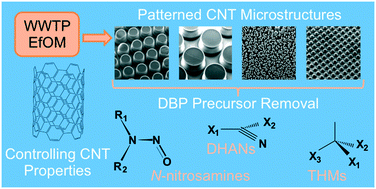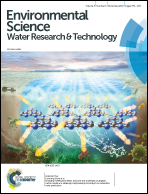Emerging investigators series: trihalomethane, dihaloacetonitrile, and total N-nitrosamine precursor adsorption by modified carbon nanotubes (CNTs) and CNT micropillars†
Abstract
Carbon nanotubes (CNTs) have been previously shown to adsorb organic precursors of disinfection byproducts (DBPs), including trihalomethanes (THMs), dihaloacetonitriles (DHANs), and total N-nitrosamines (TONO). The goal of this study is to elucidate CNT physical and chemical properties that enhance DBP precursor adsorption and provide proof-of-concept evidence to support a novel CNT-based application mode. Batch sorption data with varying CNT types, doses, and pH were analyzed with numerical models which revealed specific surface area controlled adsorption of THM and DHAN precursors and cumulative pore volume and surface oxygen content controlled adsorption of TONO precursors. To facilitate assessment of TONO precursors in low flow continuous flow sorption systems, a surrogate was developed using metrics from asymmetric flow field-flow fractionation with inline fluorescence detection and whole water fluorescence excitation-emission matrices (R2 = 0.576). Using this surrogate, we showed that affixed, CNT micropillars were capable of sorbing TONO precursors in continuous flow systems. These findings inform future modification of CNTs and provide proof-of-concept for development of structured CNT bundles for enhanced adsorption of TONO precursors.

- This article is part of the themed collection: Emerging Investigator Series


 Please wait while we load your content...
Please wait while we load your content...